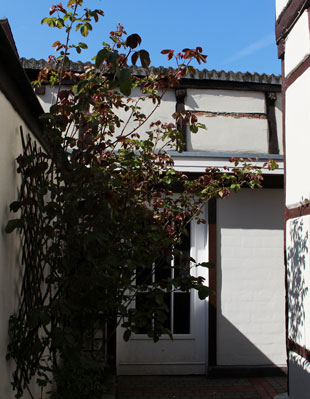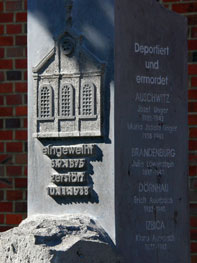Jewish cemetery
and synagogues
Desecration of the cemetery left only
a few gravestones remaining.
Continue
here
The Jewish cemetery

The first Jewish cemetery from about 1600 was located on a sandy rampart outside the town wall. The path to the cemetery was then called “Judenwall”. The people of Telgte razed their fortifications at the end of the 18th century. The Jewish community sued the town for allowing sand to be taken from the rampart and disturbing the peace of the dead. The dispute dragged on until the new Jewish cemetery was built on the Hagen around 1820.
In January 1941, the mayor declared Telgte to be “free of Jews”.
On 9 January 1941, the mayor declared Telgte to be “free of Jews”. In 1942, the town bought the cemetery for 400 RM and had gravestones, grave surrounds, and the cemetery wall removed in order to use the material to repair flood damage to the Ems weir. Only the gravestones of the last three people buried were found again after the end of the Second World War in the cellar of the burnt down party house. A memorial plaque on the large Ems weir remembers the desecration of the graves.

In 1945, the three surviving gravestones (of Leni Auerbach, d. 1932; Max Auerbach, d. 1935; and Moritz Auerbach, d. 1936) were re-erected in the rebuilt cemetery. Max Auerbach was reburied in Münster in 1962. It is not known who saved these gravestones from destruction.
In 2005, the association “Erinnerung und Mahnung” (Reminding and Warning) redesigned the cemetery in its current form and handed it over to the Jewish community of Münster.
The synagogues in Telgte
Between house walls – one individual showed courage
The building of the “old” Telgte synagogue is located inside a complex of buildings between Steinstraße and Emsstraße. Used as a storehouse for a good 200 years, the building was extended around 1740 by its Jewish owners, who lived in the surrounding houses. From then onwards, it served as a synagogue, and for a time as a school for the now eight-family-strong community.

was used as a synagogue until 1875
View of Königstraße, Telgte; above the roofs can be seen the tower of the synagogue destroyed in 1938

View of Königstraße, Telgte; above the roofs can be seen the tower of the synagogue destroyed in 1938
By the mid-19th century, the community had grown to around 80 members. After a long process of planning, a new synagogue was built on Königstraße and consecrated on 5 September 1875. Besides the prayer room, the synagogue also contained a schoolroom where the Jewish children were taught from 1875 to 1885, and from 1897 to 1899.




View of the “Judengängsken”, a narrow alley that led between Ritterstraße and Königstraße to the synagogue.
“I don’t
destroy churches”.
The synagogue in Telgte was not destroyed on the night of 9-10 November 1938 (Reichspogromnacht), but on the following night.
This was because one individual had the courage to refuse involvement in the synagogue’s destruction. The SA feared a major fire given how densely built it was around the synagogue, and therefore ordered the head of the RAD (Reich Labour Service) in Telgte, Colonel Sergeant Robert Weber, to go with his detachment armed with pick and spade to demolish the Telgte synagogue.
“Had a few hundred thousand acted like that during the Nazi era, Germany would have been spared a great deal”.
But Weber refused to carry out the order: “I don’t destroy churches”. The day after the synagogue had been burned down, he noted in his diary: “Synagogue destroyed. I was there briefly in the afternoon. Half of Telgte at the scene. Greatest cultural disgrace”. At the trial of the arsonists in 1947, the presiding judge said in open court: “Had a few hundred thousand acted like that during the Nazi era, Germany would have been spared a great deal”.

Content provided by: Verein Erinnerung und Mahnung, 48291 Telgte, www.erinnerung-und-mahnung.de; further information: memorial book for the Telgte victims of National Socialism, Telgte 2017
Photo credits: 9, photo of Königstraße: Telgte municipal archives; other photos 1-8 and 10-15: Renate Becks, Telgte





